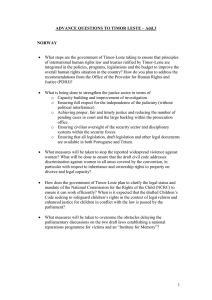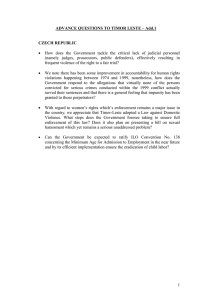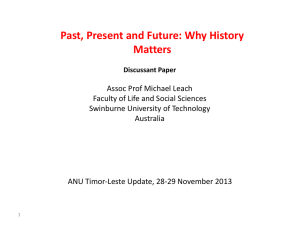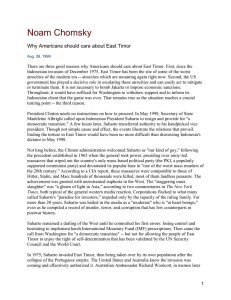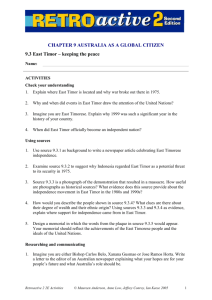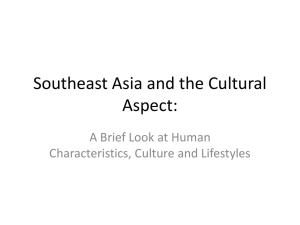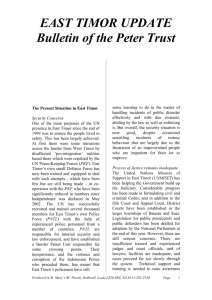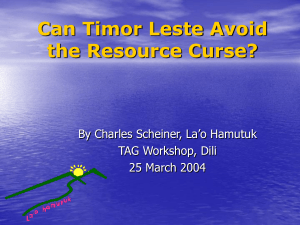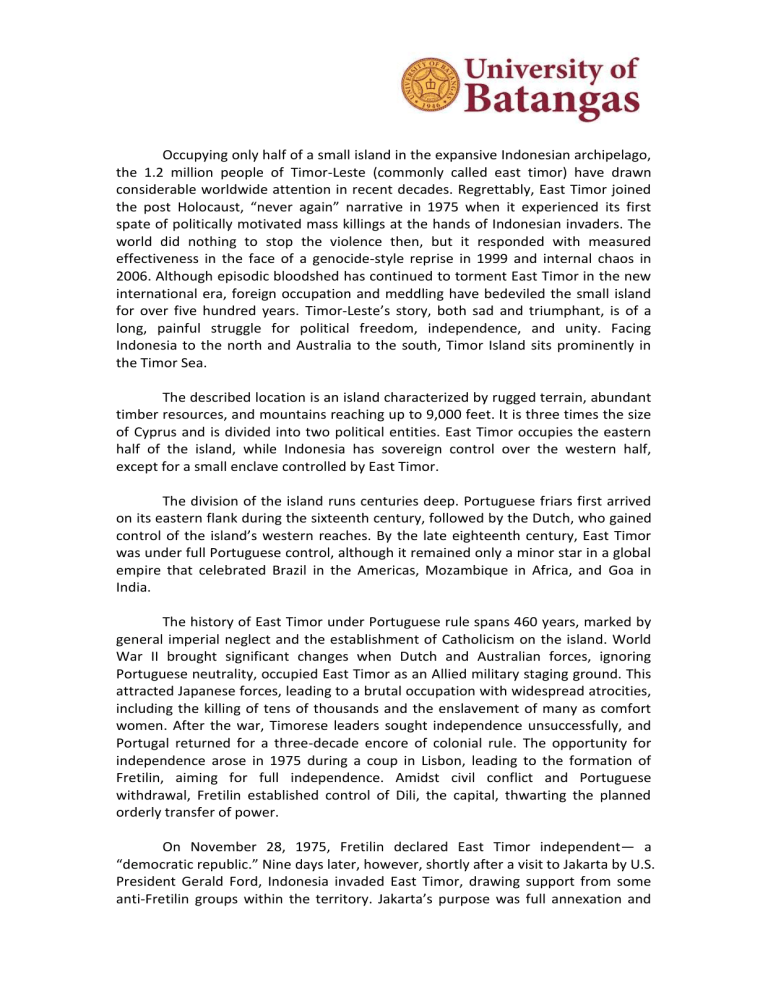
Occupying only half of a small island in the expansive Indonesian archipelago, the 1.2 million people of Timor-Leste (commonly called east timor) have drawn considerable worldwide attention in recent decades. Regrettably, East Timor joined the post Holocaust, “never again” narrative in 1975 when it experienced its first spate of politically motivated mass killings at the hands of Indonesian invaders. The world did nothing to stop the violence then, but it responded with measured effectiveness in the face of a genocide-style reprise in 1999 and internal chaos in 2006. Although episodic bloodshed has continued to torment East Timor in the new international era, foreign occupation and meddling have bedeviled the small island for over five hundred years. Timor-Leste’s story, both sad and triumphant, is of a long, painful struggle for political freedom, independence, and unity. Facing Indonesia to the north and Australia to the south, Timor Island sits prominently in the Timor Sea. The described location is an island characterized by rugged terrain, abundant timber resources, and mountains reaching up to 9,000 feet. It is three times the size of Cyprus and is divided into two political entities. East Timor occupies the eastern half of the island, while Indonesia has sovereign control over the western half, except for a small enclave controlled by East Timor. The division of the island runs centuries deep. Portuguese friars first arrived on its eastern flank during the sixteenth century, followed by the Dutch, who gained control of the island’s western reaches. By the late eighteenth century, East Timor was under full Portuguese control, although it remained only a minor star in a global empire that celebrated Brazil in the Americas, Mozambique in Africa, and Goa in India. The history of East Timor under Portuguese rule spans 460 years, marked by general imperial neglect and the establishment of Catholicism on the island. World War II brought significant changes when Dutch and Australian forces, ignoring Portuguese neutrality, occupied East Timor as an Allied military staging ground. This attracted Japanese forces, leading to a brutal occupation with widespread atrocities, including the killing of tens of thousands and the enslavement of many as comfort women. After the war, Timorese leaders sought independence unsuccessfully, and Portugal returned for a three-decade encore of colonial rule. The opportunity for independence arose in 1975 during a coup in Lisbon, leading to the formation of Fretilin, aiming for full independence. Amidst civil conflict and Portuguese withdrawal, Fretilin established control of Dili, the capital, thwarting the planned orderly transfer of power. On November 28, 1975, Fretilin declared East Timor independent— a “democratic republic.” Nine days later, however, shortly after a visit to Jakarta by U.S. President Gerald Ford, Indonesia invaded East Timor, drawing support from some anti-Fretilin groups within the territory. Jakarta’s purpose was full annexation and unification of Timor under the Indonesian flag. Decades later, declassified government documents released in Washington, D.C., confirmed the Ford administration’s knowledge and support of the invasion. The annexation of East Timor by Indonesia, led by General Suharto, was fueled by fears of Fretilin's Marxist orientation and the context of communist victories in Southeast Asia. The Indonesian military used brutal tactics, resulting in the deaths of an estimated 100,000 Timorese out of a population of 650,000. Suharto declared East Timor Indonesia's twenty-seventh province, facing international condemnation, though the United States and its allies remained largely silent. Australia formally recognized the annexation, while the United Nations condemned it and granted observer status to Fretilin. The years of Indonesian control were marked by continued suppression, with thousands of Timorese facing imprisonment or execution. Between 1974 and 1999, around 20,000 Timorese died in armed clashes or extrajudicial killings, and an additional 80,000 died from preventable illness or starvation. In total, close to one-quarter of East Timor’s pre1975 population died during the twenty-five years of Suharto’s occupation. Armed resistance continued during the period, led principally by Fretilin’s military wing Falantil (Forces Amadas de Libertação Nacional de Timor Leste). Over time, Falantil weakened and Fretilin turned increasingly to political means, nonviolence, and efforts to raise international awareness of East Timor’s plight. Suharto, in an effort to diminish foreign sympathy and silence critics, closed East Timor to outsiders for an extended period, effectively controlling information. This strategy succeeded, and during the 1980s, the international consciousness largely lost sight of the East Timor issue. Suharto's attempts to integrate East Timor with Indonesia faced significant challenges. The Catholic majority in East Timor differed from Indonesia's Muslim population, and there was a lack of shared history, language, or culture between the two. Additionally, the impoverished and war-torn East Timorese population did not benefit from Indonesia's rapid economic growth. While economic conditions showed marginal improvement in the 1980s with limited development aid from Jakarta, the economic dynamism experienced in Java was distant from the Timorese reality. In seeking unity and direction, the Timorese turned to their local communities and Catholic leaders, rather than relying on Suharto's New Order government. In 1988, East Timor was finally reopened by Suharto. It was a significant shift in policy. Pope John Paul II seized the opportunity to visit a year later, a landmark event that sparked proindependence demonstrations, which were forcibly suppressed by Indonesian security forces. Following the papal visit, a pattern of popular protest and harsh military repression emerged. In 1991, an especially appalling massacre of defenseless protesters occurred at the Santa Cruz cemetery in Dili. Congregating themselves to memorialize the death of Timorese students killed days earlier by security forces, scores of young people were suddenly targeted in a vicious melee of bloodshed resulting in seventy dead and countless wounded. Much to the dismay of Indonesian political and military leaders, disturbing video images of the slaughter were smuggled out of East Timor by foreign journalists and broadcasted internationally. Suddenly, East Timor’s long saga of occupation drew renewed global attention. Although never a cause célèbre on the scale of the antiapartheid movement or the ongoing campaign for Tibetan autonomy, East Timor retained a solid core of champions abroad. Throughout the 1990s, numerous international human rights groups stepped up pressure on Suharto’s government. The independence movement received a major boost in 1996 when two longtime Timorese leaders, Bishop Carlos Filipe Ximenes Belo and Jose RamosHorta, were jointly awarded the Nobel Peace Prize. The movement also featured an important Mandelaesque face for its cause, that of imprisoned XANANA GUSMAO Polit Politics and Government of Southeast Asia ics and Government of Southeast Asia 196 poet-warrior Kay Rala “Xanana” Gusmao, known for his leadership of Fretilin guerrillas and his impassioned prison writings during long years of confinement. In the end, it wasn’t renewed international activism, Nobel level attention, or Xanana’s growing status that triggered events that led to independence. In the new international era, the powerful forces of globalizing markets and Asia’s financial collapse put into motion events that would end Suharto’s occupation. In May 1998, amidst the financial contagion rocking Southeast Asia, Suharto’s government collapsed in spectacular fashion. The economic crisis and IMF rescue programs ignited public anger and revealed the depth of Suharto’s mismanagement and his family’s corrupt dealings. Social disruption lasting for weeks culminated with intense anti-Suharto street protests in Jakarta and elsewhere. Succumbing to the loss of international legitimacy and facing unyielding domestic pressure, the once invincible Suharto resigned in political disgrace. Consequently, East Timor’s fate followed a new course. Only weeks after Suharto’s resignation, B. J. Habibie, Indonesia’s new president, floated the idea of a “special status” for East Timor. A few months later he announced plans for a UNsupervised referendum where Timorese could choose between “autonomy within Indonesia” or “independence.” It was a political gamble. Not only might the vote fall in favor of independence, but offering it could fuel separatist aspirations held by other groups within Indonesia. Smoldering irredentist movements in Aceh and Irian Jaya in particular seemed prone to such trajectories. Undeterred, President Habibie pursued the referendum, believing that Indonesian goodwill on post-Suharto refothe East Timor controversy could foster international respect for his rm agenda. Desperately enmeshed in Indonesia’s worsening economic crisis, Habibie saw East Timor as a mechanism to restore confidence among international observers and foreign investors. In negotiations for the United Nations' role in a planned referendum, President Habibie of Indonesia refused foreign peacekeepers, leaving the United Nations Assistance Mission in East Timor (UNAMET) to rely on local security. The referendum took place on August 30, 1999, with a remarkable turnout of over 98 percent of registered voters. Despite fears and violence orchestrated by pro-autonomy militias backed by elements within the Indonesian military, almost four out of five residents (79 percent) voted for full independence. The aftermath saw brutal attacks by pro-Indonesia militias, leading to widespread chaos, torture, murder, and evidence of mass graves. As the Indonesian military failed to restore order promptly, a refugee crisis unfolded, with 250,000 Timorese fleeing into Indonesian territory. International attention and calls for intervention grew, and an Australian-led peacekeeping force, INTERFET, entered East Timor with unprecedented speed. Overwhelmed militias were subdued, allowing the referendum's results to pave the way for Timorese self-rule. In October 1999, the Indonesian Parliament declared the 1976 annexation of East Timor void, and INTERFET was replaced by the United Nations Transitional Administration in East Timor (UNTAET). Under UNTAET, East Timor was successfully governed, refugees were resettled, and elections were managed. Sergio Vieira de Mello, a respected Brazilian-born diplomat, served as East Timor's chief executive during this transitional period. Following its hard-won independence, Timor-Leste celebrated with fireworks and festivities, attended by world leaders like Kofi Annan, Bill Clinton, and Australian Prime Minister John Howard. Xanana Gusmao, a freedom fighter and former political prisoner, became the country's first president. The United Nations Mission of Support in East Timor (UNMISET) took over from UNTAET to assist in early statehood, involving 5,000 security forces and 500 foreign advisers. UNMISET, initially intended for one year, lasted three and was succeeded by the United Nations Office in East Timor (UNOTIL) in 2005. Despite newfound statehood, Timor-Leste faced challenges, including political infighting, regime instability, and endemic poverty. Political conditions worsened in 2006, leading to violence and chaos. An Australian-led peacekeeping mission, Operation Astute, was deployed, followed by the establishment of a new UN mission, the United Nations Integrated Mission in Timor-Leste (UNMIT). Initially authorized until early 2009, UNMIT aimed to institutionalize democracy with civilian advisers and 1,600 armed UN police officers. A new round of political hostilities after parliamentary elections in 2007 and a double assassination attempt on the president and prime minister in early 2008 underscored the depth of Timor-Leste’s ongoing political fragility. UNMIT troops stayed through 2012 but transferred all policing functions to national police in 2011. In an encouraging sign, presidential elections in May 2012 went off peacefully. Parliamentary elections in July of that year were also conducted without violence. Nevertheless, the necessary presence of international authorities and security forces since de jure independence renders the Timorese’s hardwon right to selfrule thus far an unfulfilled promise. De facto independence lies somewhere in the future. The most significant colonial legacy of the Portuguese was religion. Ninety-six percent of Timor-Leste’s population is Roman Catholic, in contrast to the Muslim presence that characterizes much of the surrounding region. Catholicism in East Timor actually strengthened under Indonesian rule due to Pancasila’s monotheistic imperative (which required citizens to indicate their religious identification). It was also strengthened by active local leaders, whose work was acknowledged by Pope John Paul II and his decision to visit the troubled island in 1989. As the moral voice of Timorese society and the arbiters of Timorese interests, local Catholic leaders fueled the territory’s resistance movement during the pre-independence period and continue to shape the country after statehood. Today, the debate over church-state relations is among the central elements of postindependence politics. Timorese political figures are divided on where churchstate lines should be drawn. Prime Minister Mari Alkatiri’s proposal to restrict religious education in public schools sparked indignation among church authorities and was ultimately defeated upon the threat of social disorder. Tensions between church leaders and Alkatiri, a Fretilin veteran and religious Muslim, persisted until he resigned under great pressure in 2006. Although Fretilin-led governments did not pursue a socialist agenda while in power, church leaders often characterize party leaders, including Alkatiri, as Marxists. In recent years, the church has developed avenues for a more forceful role in electoral politics. Church policy disallows bishops and priests from formally endorsing parties or candidates during services, but outside church walls they are encouraged to speak openly about their preferences. State funds are also used to support the church, an action justified, in President Ramos Horta’s words, “as an obligation of the State to the oldest and most credible institution in our Nation.” Many of East Timor’s most prominent independence leaders continue in pivotal leadership roles in the post-independence period. Having emerged from a seminarytrained class of mestizo elites, intellectuals, and civil servants, these leaders took their cues from the political Left in Portugal during their formative years in the 1970s. Less ideological today than before, veteran independence leaders now jockey for positions in government as partners and rivals hoping to navigate the young country through its seemingly insurmountable challenges. Among Timor-Leste's prominent leaders is Xanana Gusmao, the country's first president and current prime minister. Known as "Xanana," he led Fretilin in the 1980s, forming a political coalition and a clandestine rebel operation after a significant Indonesian offensive. Xanana, often compared to figures like Che Guevara and Nelson Mandela, became the international face of Timorese courage, rejecting offers of exile during his long imprisonment in Jakarta. He pressured Suharto for an independence referendum, symbolizing Timor-Leste's struggle. Jose Ramos Horta, another influential figure, fled East Timor just before the 1975 Indonesian takeover. As an observer-representative at the United Nations, he advocated for international pressure on Suharto's regime. In 1988, Ramos Horta, a joint Nobel laureate with Bishop Carlos Ximenes Belo, pursued nonviolent resistance and later served as Timor-Leste's second elected president. Despite granting clemency to his 2008 assassins, Ramos Horta's legendary ambassadorial history gives him significant moral authority. In 2012, Ramos-Horta faced reelection but refused public campaigning, respecting former Fretilin guerilla opponents. Defeated in the first round, he facilitated a peaceful transfer of presidential power by urging runoff candidates to tone down rhetoric for the country's benefit. Mari Alkatiri, also a Fretilin founder, remains another prominent figure. He served a tumultuous four-year stint as prime minister, a position with greater constitutional authority and policymaking power than the president has. Interparty divisions and rivalries with Xanana, Ramos-Horta, and Catholic leaders forced him to resign in 2006, but he remains active as a Fretilin party leader in Parliament. Another heroic figure to many Timorese, former Falantil Major-General Jose Maria Vasconcelos, known as “Taur Matan Rauk” (Tetum for “Two Sharp Eyes”), recently rose to the presidency in 2012. Though weak as institutions, the national Parliament and the country’s political parties are important vehicles for political expression and contestation in Timor-Leste’s embryonic democracy. The promise of a healthy democracy rests on how well these institutions develop. The extent to which political figures involved in parliamentary politics choose to stay within the bounds of peaceful conflict is among the crucial questions facing the country. These bounds were pushed after the 2007 election when difficulties surfaced in forming a parliamentary government and choosing a prime minister. Fretilin, now a political party, had won the most seats but was unable to find a partner and attempted to form a minority government. A minority government was unacceptable to other seated parties. The possibility of a unity government of all parties later surfaced, but talks broke down despite President RamosHorta’s attempts at mediation. Ultimately an alliance government emerged without Fretilin and with Xanana Gusmao, who had recently begun his own party, as prime minister. Fretilin protested the outcome, and Dili’s streets exploded with angry house burnings and vandalism. This time, however, no deaths were reported. Alkatiri appealed to Fretilin’s supporters to protest using civil methods, but he maintained for months that Xanana’s government was illegitimate. The 65member unicameral National Parliament currently seats four of the twenty-one parties that contested peacefully in the 2012 general elections. A proportional representation partylist ballot determines seat allocation. By law, at least one in three of all candidates on party lists are required to be women. Fretilin has won nearly 30 percent of the total vote in the past two elections, but it is no longer the most influential faction in Timorese politics. Dampening Fretilin’s dominance has been the party work of Xanana Gusmao, who founded the National Congress for Timorese Reconstruction Party (CRNT) prior to the 2007 national elections. CRNT won 24 percent of the popular vote in 2007 and 37 percent of the vote in 2012. Following the 2012 election, CRNT and Fretilin again engaged in discussions to form a unity government. Timor-Leste’s state is dependent and fragile. Technically sovereign, it can be described (somewhat singularly) as an “infant state”—a state engaged in a needy, agnatic relationship with the international community through its UN parentage. Although sometimes classified as a failed state, Timor-Leste is so new as a political entity that it is difficult to equate it with countries that genuinely experienced a measurable loss of sovereign control, central authority, or capacity for self-governance (such as Somalia, Zimbabwe, or Afghanistan). Having yet to achieve a measurable degree of state autonomy or capacity in the first place, Timor-Leste is disproportionately dependent on foreign support for its very being. The early years of Timor-Leste's independence saw the United Nations heavily involved in managing various functions of the state, including security, government, social services, and justice. Multiple UN-led operations were undertaken from 1999 to 2012, playing a crucial role in the country's emancipation and stability. However, concerns arose about Timor-Leste's future as a fully sovereign state and the need to transition away from UN paternalism. President Ramos-Horta advocated for a continued UN presence to guide the country out of its infancy. Despite progress, questions lingered about the legitimacy of the state and how Timorese consented to authority. The influence of the Catholic Church and key independence figures remained strong, but confidence in the state and its political institutions was uncertain. Growing regional divisions, known as the east-west divide, added challenges to the state's legitimacy and territorial integrity. Timor-Leste's democratic institutions were weak and underdeveloped, facing threats from social disorder and violence. The events of 2006, marked by political chaos, riots, and clashes, revealed the fragility of the country's democracy. Internal factors, such as disgruntled soldiers and regional cleavages, contributed to the challenges. The events of 2007 and 2008, including electoral violence and an assassination attempt on President Ramos-Horta, further highlighted the precarious state of Timor-Leste's democracy. The country was described as an "ambiguous" regime, with democratization progress hindered by internal conflicts and a political culture prone to violence. Hopeful observers saw the death of Alfredo Reinado, the estranged army major who launched the 2006 mutiny and the 2008 assassination coup, as the beginning of the end of a destabilizing rebel movement that threatened democracy. Nonviolent presidential and parliamentary elections in 2012 have also raised expectations, but it is far too early to label Timor-Leste’s transition to democracy complete. Ramos-Horta, favoring forgiveness over punitive justice, and pointing to peaceful elections and recent economic gains, believes that “the country is maturing” and that “a new chapter has begun.” A 1996 report from the UNDP tragically described Timor-Leste as Asia’s least developed country—a country “chained to poverty.” Independence has improved economic conditions and development in the country but many economic deficiencies remain. Aside from promising revenues derived from oil extraction in the Timor Sea, the young country enjoys limited economic prospects, especially from a household level perspective. New autonomy and authority to allocate state resources from oil revenues has spawned infighting because there is little institutional capacity to deliver such allocation. A two-tier oil/nonoil economy has emerged, creating both opportunities and risks. Timor-Leste's economy is predominantly characterized by subsistence agriculture, with almost a quarter of the population relying on food assistance during lean months. The country's overall economic activities are limited to oil, coffee, and some handicrafts, while manufacturing is negligible. Development assistance and oil revenues are crucial for the country's economic survival, as it is wholly dependent on imports to meet its population's needs. Despite some growth since 2002, especially after 2007 when coffee exports increased, Timor-Leste faces challenges in economic development. The oil sector accounts for 75% of the GDP, and the country's structural weaknesses persist in a two-tier economy. While oil revenues contribute to a sovereign fund, the TimorLeste Petroleum Fund, and have grown significantly, their impact on improving everyday lives is slow. Living standards in Timor-Leste are marked by a high poverty rate of 41%, and the overall human development record is disheartening, with a literacy rate near 50%. Infrastructure initiatives, including a push for public infrastructure by Prime Minister Gusmao, aim to address unemployment, which averages 20%, particularly in urban areas. The country's annual budget has seen a substantial increase, reaching $1.3 billion in 2011, mainly due to infrastructure projects. Timor-Leste faces challenges attracting foreign investment due to a small and poorly educated population, remote location, and unfavorable rankings in the Global Competitiveness Index and Bloomberg Economic Momentum Index. The government's active role in economic development is deemed necessary, as waiting for private investment alone is considered impractical. Of course, the greatest risks lie in the oil economy itself. Increasing alongside rising hydrocarbon driven revenues are the risks of falling into the “oil curse.” Common to many small petrostates, the oil curse leads to high-stake conflict among elites, authoritarian impulses, and corruption. Nevertheless, the opportunity exists for Timor-Leste to learn from mistakes made elsewhere. If political disunity, the temptation for corruption, and inequitable distribution of revenues can be avoided, it is possible that oil wealth will be a blessing to human development, not a curse. As it seeks to wean itself from outside protection, Timor-Leste’s relationship with the United Nations remains its most crucial foreign policy priority. Nevertheless, the young country’s evolving politics is producing a coherent foreign policy agenda and debate. Dili’s principal bilateral relations are with Indonesia, Australia, and (increasingly) China. It also desires a healthy relationship with ASEAN. Relations between Timor-Leste and Indonesia remain contentious among Timorese due to historical resentments stemming from Suharto's occupation and the post-referendum violence in 1999. The establishment of the Timor-Leste Commission of Truth and Friendship in 2005, a bilateral initiative aimed at smoothing relations, has been criticized by some Timorese who perceive it as granting impunity to Indonesian perpetrators. While Xanana supports the commission, church officials, UNMIT, and international NGOs questioned its legitimacy. Timor-Leste's relations with Australia are complex, marked by territorial disputes but also instances of cooperation, such as Australia's peacekeeping efforts in 2006. Some within Timor-Leste are wary of perceived neocolonial designs by Canberra. Ramos-Horta and Xanana are less concerned about this possibility compared to Fretilin and Mari Alkatiri, who looks to China and Portugal as patrons. Portugal, recently overtaken by Australia as Timor-Leste's largest aid donor, maintains ties with its former colony. China, supportive of Fretilin during the Cold War, has established diplomatic relations with Timor-Leste and sent troops to support UNTAET. Recent moves by China aim to preempt Taiwan's influence in Timor-Leste, and its interest is seen as more economic than political. China provides increasing foreign aid, finances government buildings including the new presidential palace, and conducts seismic studies for oil and gas exploration in Timor-Leste. Timor-Leste even donated $500,000 to China in 2008 to support recovery efforts after the Sichuan earthquake, showcasing a goodwill gesture and highlighting the evolving dynamics in their relationship. With respect to international organizations, Timor-Leste’s key relations are with the Asian Development Bank, where membership was established in 2004, and ASEAN, where membership hopes have been inhibited by the criterion that Dili establish foreign embassies in all ten ASEAN capitals. (Timor-Leste has only a handful of diplomatic missions worldwide.) With support from Indonesia, however, ASEAN membership may be realized in 2013. WTO membership is an even more distant hope, although memberships with the IMF and World Bank have resulted in a proliferation of project-based aid initiatives. The full dignity of independence celebrated by Timor-Leste in 2002 came at a heavy price— achieved after 460 years of Portuguese control; three merciless years of Japanese occupation; a thirty-year return of Portuguese rule following World War II; a failed attempt at independence in 1975; twenty-five years of a brutal occupation by Indonesia’s Suharto; an independence referendum; a scorched-earth campaign by antiindependence militias; a refugee crisis; a dramatic Australian led peacekeeping operation; and an ambitious UN mission that governed East Timor’s final transition to statehood. Elections, democratic institutions, and membership in international organizations have since followed, but political stability and economic development have remained elusive. The “never again” narrative, into which Timor-Leste’s history is inseparably woven, has recently adopted a new term: chega! Portuguese for “enough!” or “stop!”. The title of a UN commissioned report on the atrocities committed under Indonesia’s occupation, Chega! might as well be a mantra for independent Timor-Leste as it seeks full self-governance. Realizing an end to episodic disorder, killing, and refugee flows is requisite for the infant state if it is to experience genuine independence and stability. Political order, elusive today, is the keystone in the delicate bridge that may someday lead Timorese to the economic and human development they so sorely deserve. Members : Amar, Bridgette Brucal, Godwin Kenn Cananua, Celeste Labayane, Ezechiel
